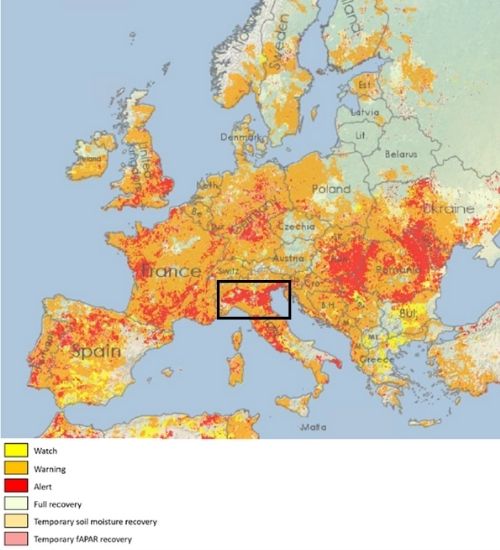
Repeated extreme weather events in Europe and Emilia-Romagna
In 2022, a severe drought hit several regions of Europe. A persistent lack of precipitation, combined with temperatures above the average, led to one of the driest summers ever experienced in Europe. Northern Italy, and the Po River basin specifically, was one of the most affected regions, with river flow reaching critical levels during summer. Unfortunately, this was not an isolated case. Since the beginning of the century, the Po River basin has been repeatedly hit by droughts (2003, 2006, 2007, 2015) despite its abundance of water resources.
The last cycle of SHERPA consultation with the Emilia-Romagna Multi-actor Platform (MAP) started in July. It is then not surprisingly that climate change and water management was the core topic of their discussions and their recently published Position Paper.
The Emilia-Romagna Region locates in Northern Italy and falls, in terms of hydrological boundaries, within the Po River Basin District. In the midst of the drought, it was possible to collect the views of local actors both on challenges and on possible solutions to manage water resources in a drought-prone area.
Water scarcity and climate change severely affect rural agriculture, tell rural actors
One Emilia-Romagna MAP member leading a cooperative farm told us that cereals, in particular wheat, have been the most affected crops by the current drought with a drop in production of about 15-20%. The main reason for these losses lies in the increase of irrigation demand for all crops, while the supply remained stable or even lowered, with visible effects both on yield quantity and quality. In addition, he told us, agricultural production is damaged also by other effects of climate variability, such as heavy precipitation, hailstorms, and late frosts. Late frosts experienced in the last years – he said – significantly affected orchard production with a loss of about 13 thousand quintals. Beyond economic loss, this also had an impact on employment because fewer yields mean less demand for labor.
Another significant challenge for the region relates to soil organic carbon. Soil organic carbon is fundamental, among other things, to ensure the quality and fertility of soils, but also to prevent erosion, retain water and mitigate climate change. In Emilia-Romagna, there is a limited stock of soil organic carbon in particular in the Po plain. This situation carbon is worsened by higher temperatures that tend to increase the loss of soil organic carbon in a vicious circle with consequences for the quality of soils and agriculture productivity.
Policy interventions and research needs
In this context, preparedness and adaptation capacity become central issues with infrastructures being of great importance. Emilia-Romagna has already several examples of reservoirs, some of them collectively managed by farmers. Water reservoirs can provide multiple benefits for agriculture both in case of drought and floods. Another innovative example, reported by a representative of an irrigation board, is to use reservoirs for electricity production thanks to floating photovoltaic plants.
Besides, policies should address inefficient uses of water. This is the case where water-intensive crops (e.g.rice) are grown on permeable soils. Which instruments, among economic incentives (e.g., water pricing) or a command-and-control policy, are best suited to disincentivize such inefficiencies is an unresolved question, said many local actors from Emilia-Romagna MAP. However, this raises the relevant issue of avoiding one-size-fits-all solutions and promoting locally designed instruments.
Incentivizing water reuse was also mentioned. The EU regulation 741/2020 sets out the minimum requirements for water reuse in agriculture and its implementation might encourage a wider application of water reuse. It is however very important to understand whether the characteristics of local reclamation systems will allow for wider use of wastewater.
Research can contribute to these priorities by addressing the issue of multiple uses of water in the context of increasing scarcity. For instance, socio-economic research can contribute to identify governance arrangements (e.g., norms, contract solutions, policy) that can ease collaboration among water users.
A key message: system thinking can move policy and research forward
Eventually, the main message emerging from the discussion is that, to face such increasing complexity there is the need, both for policy and research, to adopt a system thinking and approach. System thinking can help to recognize the multiple dimensions and interconnectedness of environmental problems and to design interventions accordingly.
